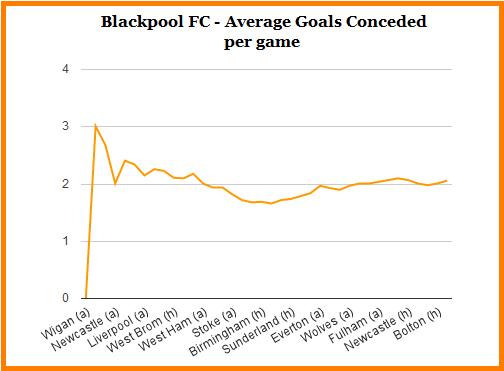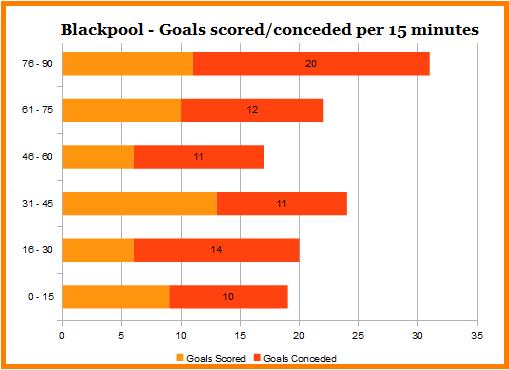On the 1st December 2010 this blog took a look at ten aspects of Blackpool’s season up to that point that were reasons behind their success. It made the assertion that should these ten aspects be sustained over the course of the season then Blackpool would stay in the Barclays Premier League. Now the season has come to an end it’s time to pick through that list and see how many stayed the course and how many fell by the wayside.
Task list
First things first, lets list the ten aspects from the original article.
Blackpool must;
- Keep on attacking teams
- Keep faith with a 4-3-3 structure
- Keep meeting teams who pay no regard to Blackpool’s style of football
- Keep doing the defensive basics
- Keep passing the ball
- Keep the long diagonal pass as a part of their game plan
- Keep the points ticking over
- Keep supplying DJ Campbell close to goal
- Keep alert at all times
As you’ll notice, there are only nine listed above. That is because two of the points from the first article were of the same nature so they’ve been condensed in to point three to avoid confusion. Perhaps, that should have been noted at the time and the post renamed ‘Nine steps to safety’. Actually, that sounds much better now.
Attacking matters
The original article picked up on the fact that Blackpool had little problem in scoring goals and at the rate they were scoring then they’d have scored 58 times by the end of the season. In fact Blackpool did keep their goals flowing and were widely lauded for their commitment to attack. Ian Holloway intended to attack the Premier League and attack he did. Blackpool ended up scoring 55 goals and they were the 8th highest scorers in the whole league and no team has scored as many goals and been relegated in the Premier League era.
Four, Three, Three
Ever since Ian Holloway has taken over the management of Blackpool football club he has advocated a 4-3-3 and he wants his teams at all levels to play the same formation. This season that formation consistently brought the best out of his players and caused all kinds of problems for many teams, especially those set up in a flat 4-4-2. From memory only two teams set up in a 4-4-2 and beat Blackpool (Fulham and Chelsea). A pre-season injury to Keith Southern meant that the 4-3-3 morphed in to a 4-2-3-1 or 4-2-1-3 and it worked well initially. It will be interesting to see how Swansea set up in the Premier League, they’ll bring a similar structure (applied differently), but will still cause trouble against any team in a standard 4-4-2.
Homework
Not many children ever appear to enjoy their homework and the panel of the Sunday Supplement on Sky Sports appear to take a similarly neglectful approach to their research of football that tends to be outside of their myopic scope. However, this was also the case for the best part of half a Premier League season as most managers who faced off against Blackpool appeared to make no concession and make clear tactical plans to cope with Blackpool. All season it appeared that only Alex McLeish made clear changes to his team structure to counter Blackpool with his 4-1-2-1-2 diamond formation.
Teams tended to favour their regular set ups against Blackpool for the most part and some suffered as a result. Blackpool’s barren run of form was partly explained by other factors, but on occasion some managers recognised that to deny time and space to Charlie Adam would stifle Blackpool and rightly so it had an effect. Another aspect that some managers finally picked up on was to press Blackpool’s back line and close down the keeper to stop them playing out from the back. This and the plan to shackle Adam seemed to be the only major concessions teams made to Blackpool all season, content to play their own game and let Blackpool play their and see who wins. This approach consistently played in to the hands of Blackpool, but as the season wore on and wins became less frequent when the concessions some teams were making combined with the errors Blackpool were making caused a lot of the poor results.
Breaking the line
It’s not a secret that Blackpool were poor defensively and the original post was made after a couple of steady defensive performances and stressed that they needed to become more and more frequent for Blackpool to stay up. In the end poor defensive shape, poor covering, poor communications, poor concentration and poor judgement cost Blackpool very dear. Blackpool conceded 78 goals at a rate of 2.05 goals per game. At the time of the original post that ratio was 1.93 and in the game since then it rose to 2.13. You can see below how around the time of the last article their goals conceded per game started to improve before picking up again at the crucial back end of the season.
Teams defend as a unit and Holloway stressed that his defence starts with his forwards, whilst this is true, the defensive basics of clearing lines safely, generally rested with the back five and a couple of midfielders. If you look at the % of successful clearances this season you can see that on average Blackpool cleared their lines successfully 61% of the time. However, the number of critical mistakes made in games never seemed to die and hung around till the end of the season. Through a quick count up (via whoscored.com) Blackpool made a total of 14 errors leading to goals being scored (Richard Kingson was the player who made the most, 3).
Tick-tock
As stated many times on the blog this season Holloway sees short passing as the foundation for Blackpool’s game, he aspires for tiki-taka style passing and at the time of the original post Blackpool were performing excellent with balls to feet with a pass completion of 77%. However, a post earlier this year noted that their passing was dropping off as teams pressed better and Blackpool became a little direct at times especially from the back and through the evaporation of the quickly taken short freekick. At season end Blackpool’s pass completion stood at 76% and if you segment the season up in to arbitrary halves then for the first half of the season Blackpool were stood at 78% and the second half at 74%.
Die-agonal
Posts on this blog and over on Up the ‘Pool have talked about the way that Blackpool have utilised the long diagonal from back to front to stretch the play and add variety. However, as the season progressed the pass did tend to become easier to read and it’s hard to pin point a goal being scored as a result, however, that’s not to say that it ceased to become useful. Only a detailed analysis would answer questions around this.
Grinding to a halt
A simple graph will confirm that Blackpool failed in keeping the points ticking over as you can see below.
Whilst it is a by-product of the team performance, it is crucial for any team to consistently pick up points throughout the season. Blackpool’s 1 win in a 16 game run hindered the steady accumulation of points and such runs breed poor habits and drain confidence and Blackpool found it hard to shrug off. As mentioned earlier about the defence, mistakes were common, team selection frustrated by injury and other things added up to test Blackpool week in week out, but they struggled to break free from the cycle till it was arguably too late given the strong end to the season that both Wolves and Wigan had.
Poached
A study of DJ Campbell’s goals in the Championship showed that he thrived on balls played between the goal line and penalty spot and the assertion was made this season that should Blackpool keep supplying the ball to him in that range then he’d keep on scoring goals all season. At the time of the original article he was on schedule to hit 8 goals for the season. In fact he made some improvements in his game, notably in his movement in dropping deep to receive the ball and his ball control did steadily improve, although he still has a tendency to misjudge his control especially if the ball bounces just in front of him. The ball tends to rise up on his first touch leaving the ball a couple of feet off the ground and fair game for any defender. However, his strength on the ball has improved as has his decision-making as to when to play a flick or hold on to the ball. DJ Campbell ended the season with 13 goals in what was an excellent season for the striker.
Capitulation
Back in December Blackpool had a developed a habit of conceding late on in the game, at that point 9 goals had been scored against them in the last 15 minutes of game which equated to 31% of the total goals conceded. As the season progressed, this never went away and this more than anything has caused Blackpool the biggest problems. By the season end Blackpool had conceded 20 goals in the last 15 minutes equating to 25%.
Mission: Failed
This article served to follow up something written some months ago and served merely to round that post off so that it could be established if the tasks ahead of Blackpool had been carried out successfully. Five out of the nine could be deemed as a success, whilst four failures and it is those four that proved most critical. However, the lines between staying up and going down were very fine in the end, Blackpool didn’t need to defend like warriors game after game or have the mental resilience to see out every game from a winning position. All they really needed was one more minute of concentration, one less misplaced clearance and they may well have stayed up. However, what Blackpool showed more than anything is that they were a team of extremes, great going forward, woeful in defence and should they ever get to this level again, then striking a greater balance will serve them better.
Follow @Tanger_Dreaming



 Blackpool News 24/7
Blackpool News 24/7
Great work again fella – excellent round up of the season – the 5-3 at Goodison was the most exciting game ive seen at our gaff in years.
Good stuff as usual.
I think your final paragraphs nails it pretty well. Whilst the finger can be pointed at a lot of areas, it was such a close run thing that the slightest improvement in just one area could have saved the whole season.
As for the long diagonals, I agree that they became less successful as the season went on. I had thought about revisiting this, but the time it would take has put me off somewhat. If my day job can give me a week’s sabbatical then maybe I’ll find the time, but the thought of doing all that research again when there is little positive to report isn’t all that encouraging!